Pytorch 使用使用CNN图像分类的实现
图像分类的实现
主要介绍了Pytorch 使用CNN图像分类的实现,文中通过示例代码介绍的非常详细,对大家的学习或者工作具有
一定的参考学习价值,需要的朋友们下面随着小编来一起学习学习吧
需求需求
在4*4的图片中,比较外围黑色像素点和内圈黑色像素点个数的大小将图片分类
如上图图片外围黑色像素点5个大于内圈黑色像素点1个分为0类反之1类
想法想法
代码代码
通过numpy、PIL构造4*4的图像数据集
构造自己的数据集类
读取数据集对数据集选取减少偏斜
cnn设计因为特征少,直接1*1卷积层
或者在4*4外围添加padding成6*6,设计2*2的卷积核得出3*3再接上全连接层
import torch
import torchvision
import torchvision.transforms as transforms
import numpy as np
from PIL import Image
构造数据集
import csv
import collections
import os
import shutil
def buildDataset(root,dataType,dataSize):
�
"""构造数据集
构造的图片存到root/{dataType}Data
图片地址和标签的csv文件存到 root/{dataType}DataInfo.csv
Args:
root:str
项目目录
dataType:str
'train'或者‘test'
dataNum:int
数据大小
Returns:
"""
dataInfo = []
dataPath = f'{root}/{dataType}Data'
if not os.path.exists(dataPath):
os.makedirs(dataPath)
else:
shutil.rmtree(dataPath)
os.mkdir(dataPath)
for i in range(dataSize):
# 创建0,1 数组
imageArray=np.random.randint(0,2,(4,4))
# 计算0,1数量得到标签
allBlackNum = collections.Counter(imageArray.flatten())[0]
innerBlackNum = collections.Counter(imageArray[1:3,1:3].flatten())[0]
label = 0 if (allBlackNum-innerBlackNum)>innerBlackNum else 1
# 将图片保存
path = f'{dataPath}/{i}.jpg'
dataInfo.append([path,label])
im = Image.fromarray(np.uint8(imageArray*255))
im = im.convert('1')
im.save(path)
# 将图片地址和标签存入csv文件
filePath = f'{root}/{dataType}DataInfo.csv'
with open(filePath, 'w') as f:
writer = csv.writer(f)
writer.writerows(dataInfo)
root=r'/Users/null/Documents/PythonProject/Classifier'
构造训练数据集
buildDataset(root,'train',20000)
构造测试数据集
buildDataset(root,'test',10000)
读取数据集
class MyDataset(torch.utils.data.Dataset):
def __init__(self, root, datacsv, transform=None):
super(MyDataset, self).__init__()
with open(f'{root}/{datacsv}', 'r') as f:
imgs = []
# 读取csv信息到imgs列表
for path,label in map(lambda line:line.rstrip().split(','),f):
imgs.append((path, int(label)))
self.imgs = imgs
self.transform = transform if transform is not None else lambda x:x
def __getitem__(self, index):
path, label = self.imgs[index]
img = self.transform(Image.open(path).convert('1'))
return img, label
def __len__(self):
return len(self.imgs)
trainData=MyDataset(root = root,datacsv='trainDataInfo.csv', transform=transforms.ToTensor())
testData=MyDataset(root = root,datacsv='testDataInfo.csv', transform=transforms.ToTensor())
处理数据集使得数据集不偏斜
import itertools
def chooseData(dataset,scale):
# 将类别为1的排序到前面
dataset.imgs.sort(key=lambda x:x[1],reverse=True)
�
# 获取类别1的数目 ,取scale倍的数组,得数据不那么偏斜
trueNum =collections.Counter(itertools.chain.from_iterable(dataset.imgs))[1]
end = min(trueNum*scale,len(dataset))
dataset.imgs=dataset.imgs[:end]
scale = 4
chooseData(trainData,scale)
chooseData(testData,scale)
len(trainData),len(testData)
(2250, 1122)
import torch.utils.data as Data
# 超参数
batchSize = 50
lr = 0.1
numEpochs = 20
trainIter = Data.DataLoader(dataset=trainData, batch_size=batchSize, shuffle=True)
testIter = Data.DataLoader(dataset=testData, batch_size=batchSize)
定义模型
from torch import nn
from torch.autograd import Variable
from torch.nn import Module,Linear,Sequential,Conv2d,ReLU,ConstantPad2d
import torch.nn.functional as F
class Net(Module):
def __init__(self):
super(Net, self).__init__()
self.cnnLayers = Sequential(
# padding添加1层常数1,设定卷积核为2*2
ConstantPad2d(1, 1),
Conv2d(1, 1, kernel_size=2, stride=2,bias=True)
)
self.linearLayers = Sequential(
Linear(9, 2)
)
def forward(self, x):
x = self.cnnLayers(x)
x = x.view(x.shape[0], -1)
x = self.linearLayers(x)
return x
class Net2(Module):
def __init__(self):
super(Net2, self).__init__()
self.cnnLayers = Sequential(
Conv2d(1, 1, kernel_size=1, stride=1,bias=True)
)
self.linearLayers = Sequential(
ReLU(),
Linear(16, 2)
)
def forward(self, x):
x = self.cnnLayers(x)
x = x.view(x.shape[0], -1)
x = self.linearLayers(x)
return x
定义损失函数
# 交叉熵损失函数
loss = nn.CrossEntropyLoss()
loss2 = nn.CrossEntropyLoss()
定义优化算法
net = Net()
optimizer = torch.optim.SGD(net.parameters(),lr = lr)
net2 = Net2()
optimizer2 = torch.optim.SGD(net2.parameters(),lr = lr)
训练模型
# 计算准确率
def evaluateAccuracy(dataIter, net):
accSum, n = 0.0, 0
�
with torch.no_grad():
for X, y in dataIter:
accSum += (net(X).argmax(dim=1) == y).float().sum().item()
n += y.shape[0]
return accSum / n
def train(net, trainIter, testIter, loss, numEpochs, batchSize,
optimizer):
for epoch in range(numEpochs):
trainLossSum, trainAccSum, n = 0.0, 0.0, 0
for X,y in trainIter:
yHat = net(X)
l = loss(yHat,y).sum()
optimizer.zero_grad()
l.backward()
optimizer.step()
# 计算训练准确度和loss
trainLossSum += l.item()
trainAccSum += (yHat.argmax(dim=1) == y).sum().item()
n += y.shape[0]
# 评估测试准确度
testAcc = evaluateAccuracy(testIter, net)
print('epoch {:d}, loss {:.4f}, train acc {:.3f}, test acc {:.3f}'.format(epoch + 1, trainLossSum / n, trainAccSum / n, testAcc))
Net模型训练
train(net, trainIter, testIter, loss, numEpochs, batchSize,optimizer)
epoch 1, loss 0.0128, train acc 0.667, test acc 0.667
epoch 2, loss 0.0118, train acc 0.683, test acc 0.760
epoch 3, loss 0.0104, train acc 0.742, test acc 0.807
epoch 4, loss 0.0093, train acc 0.769, test acc 0.772
epoch 5, loss 0.0085, train acc 0.797, test acc 0.745
epoch 6, loss 0.0084, train acc 0.798, test acc 0.807
epoch 7, loss 0.0082, train acc 0.804, test acc 0.816
epoch 8, loss 0.0078, train acc 0.816, test acc 0.812
epoch 9, loss 0.0077, train acc 0.818, test acc 0.817
epoch 10, loss 0.0074, train acc 0.824, test acc 0.826
epoch 11, loss 0.0072, train acc 0.836, test acc 0.819
epoch 12, loss 0.0075, train acc 0.823, test acc 0.829
epoch 13, loss 0.0071, train acc 0.839, test acc 0.797
epoch 14, loss 0.0067, train acc 0.849, test acc 0.824
epoch 15, loss 0.0069, train acc 0.848, test acc 0.843
epoch 16, loss 0.0064, train acc 0.864, test acc 0.851
epoch 17, loss 0.0062, train acc 0.867, test acc 0.780
epoch 18, loss 0.0060, train acc 0.871, test acc 0.864
epoch 19, loss 0.0057, train acc 0.881, test acc 0.890
epoch 20, loss 0.0055, train acc 0.885, test acc 0.897
Net2模型训练
# batchSize = 50
# lr = 0.1
# numEpochs = 15 下得出的结果
train(net2, trainIter, testIter, loss2, numEpochs, batchSize,optimizer2)
epoch 1, loss 0.0119, train acc 0.638, test acc 0.676
epoch 2, loss 0.0079, train acc 0.823, test acc 0.986
epoch 3, loss 0.0046, train acc 0.987, test acc 0.977
epoch 4, loss 0.0030, train acc 0.983, test acc 0.973
epoch 5, loss 0.0023, train acc 0.981, test acc 0.976
epoch 6, loss 0.0019, train acc 0.980, test acc 0.988
epoch 7, loss 0.0016, train acc 0.984, test acc 0.984
epoch 8, loss 0.0014, train acc 0.985, test acc 0.986
epoch 9, loss 0.0013, train acc 0.987, test acc 0.992
epoch 10, loss 0.0011, train acc 0.989, test acc 0.993
epoch 11, loss 0.0010, train acc 0.989, test acc 0.996
epoch 12, loss 0.0010, train acc 0.992, test acc 0.994
epoch 13, loss 0.0009, train acc 0.993, test acc 0.994
epoch 14, loss 0.0008, train acc 0.995, test acc 0.996
epoch 15, loss 0.0008, train acc 0.994, test acc 0.998
测试测试
test = torch.Tensor([[[[0,0,0,0],[0,1,1,0],[0,1,1,0],[0,0,0,0]]],
[[[1,1,1,1],[1,0,0,1],[1,0,0,1],[1,1,1,1]]],
[[[0,1,0,1],[1,0,0,1],[1,0,0,1],[0,0,0,1]]],
[[[0,1,1,1],[1,0,0,1],[1,0,0,1],[0,0,0,1]]],
[[[0,0,1,1],[1,0,0,1],[1,0,0,1],[1,0,1,0]]],
[[[0,0,1,0],[0,1,0,1],[0,0,1,1],[1,0,1,0]]],
[[[1,1,1,0],[1,0,0,1],[1,0,1,1],[1,0,1,1]]]
])
�
target=torch.Tensor([0,1,0,1,1,0,1])
test
tensor([[[[0., 0., 0., 0.],
[0., 1., 1., 0.],
[0., 1., 1., 0.],
[0., 0., 0., 0.]]],
[[[1., 1., 1., 1.],
[1., 0., 0., 1.],
[1., 0., 0., 1.],
[1., 1., 1., 1.]]],
[[[0., 1., 0., 1.],
[1., 0., 0., 1.],
[1., 0., 0., 1.],
[0., 0., 0., 1.]]],
[[[0., 1., 1., 1.],
[1., 0., 0., 1.],
[1., 0., 0., 1.],
[0., 0., 0., 1.]]],
[[[0., 0., 1., 1.],
[1., 0., 0., 1.],
[1., 0., 0., 1.],
[1., 0., 1., 0.]]],
[[[0., 0., 1., 0.],
[0., 1., 0., 1.],
[0., 0., 1., 1.],
[1., 0., 1., 0.]]],
[[[1., 1., 1., 0.],
[1., 0., 0., 1.],
[1., 0., 1., 1.],
[1., 0., 1., 1.]]]])
with torch.no_grad():
output = net(test)
output2 = net2(test)
predictions =output.argmax(dim=1)
predictions2 =output2.argmax(dim=1)
# 比较结果
print(f'Net测试结果{predictions.eq(target)}')
print(f'Net2测试结果{predictions2.eq(target)}')
Net测试结果tensor([ True, True, False, True, True, True, True])
Net2测试结果tensor([False, True, False, True, True, False, True])
到此这篇关于Pytorch 使用CNN图像分类的实现的文章就介绍到这了,更多相关Pytorch CNN图像分类内容请搜索我们以前的文
章或继续浏览下面的相关文章希望大家以后多多支持我们!
�
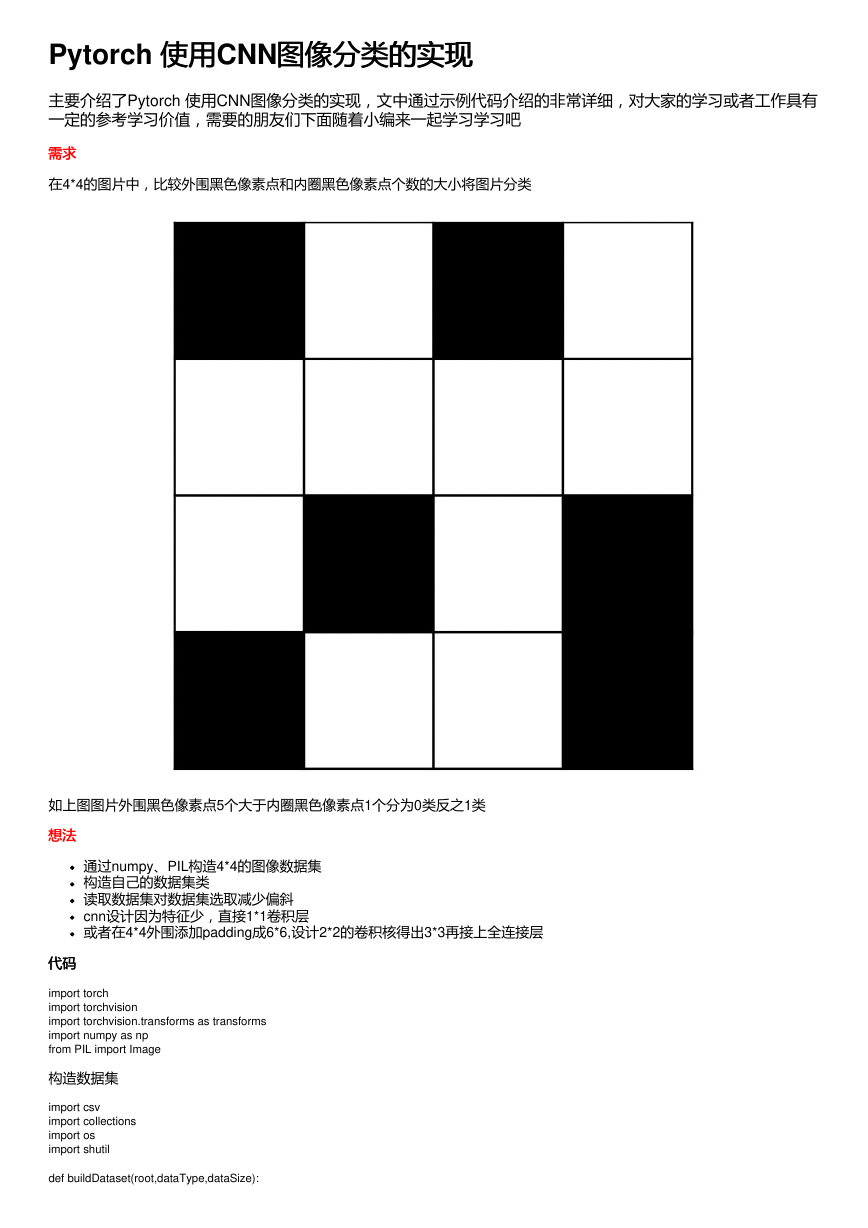
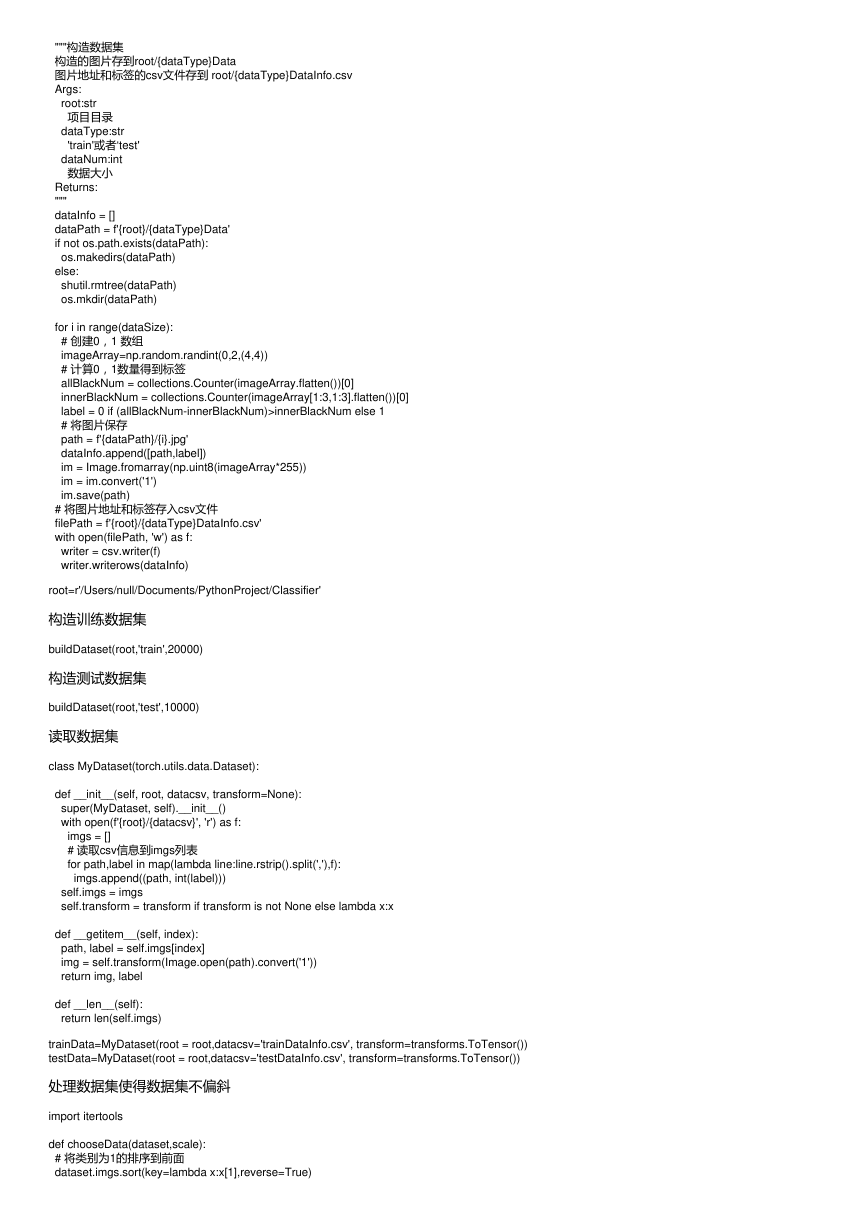
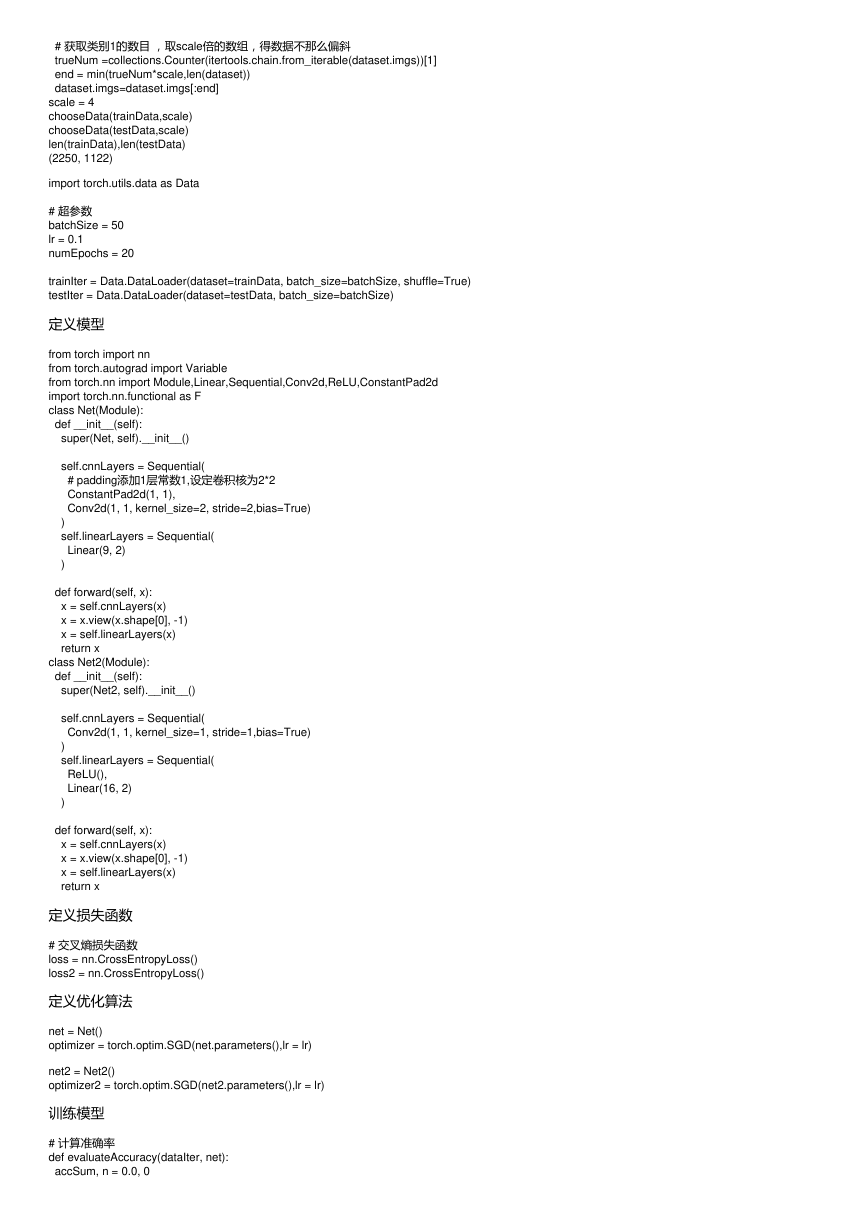
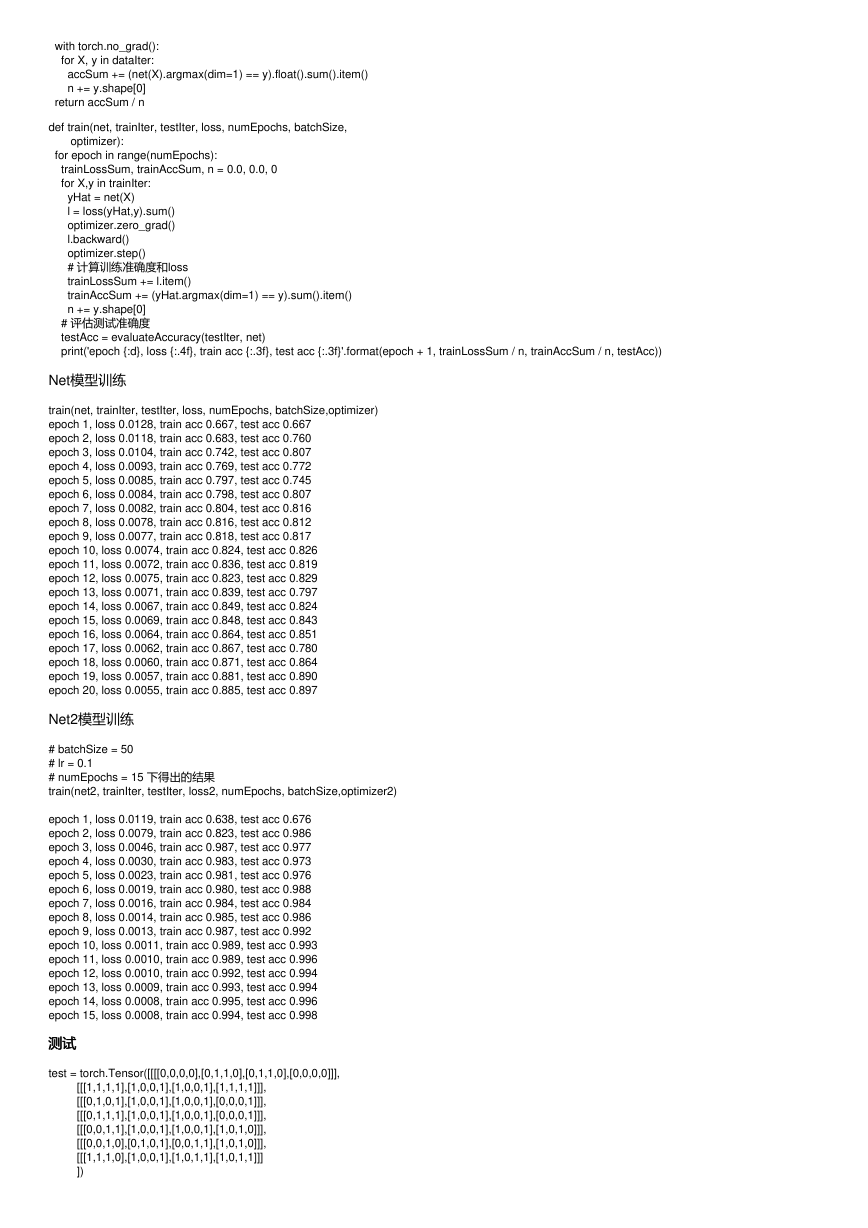
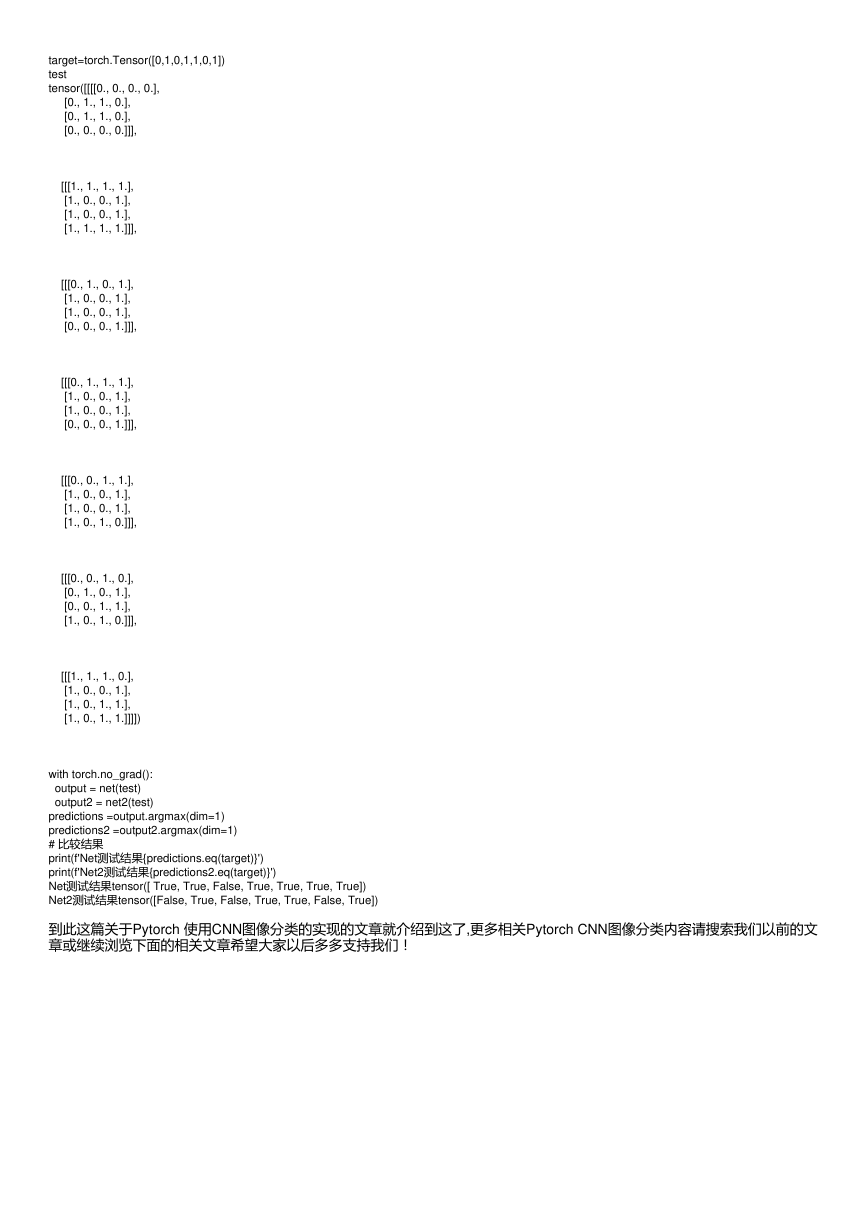





 2023年江西萍乡中考道德与法治真题及答案.doc
2023年江西萍乡中考道德与法治真题及答案.doc 2012年重庆南川中考生物真题及答案.doc
2012年重庆南川中考生物真题及答案.doc 2013年江西师范大学地理学综合及文艺理论基础考研真题.doc
2013年江西师范大学地理学综合及文艺理论基础考研真题.doc 2020年四川甘孜小升初语文真题及答案I卷.doc
2020年四川甘孜小升初语文真题及答案I卷.doc 2020年注册岩土工程师专业基础考试真题及答案.doc
2020年注册岩土工程师专业基础考试真题及答案.doc 2023-2024学年福建省厦门市九年级上学期数学月考试题及答案.doc
2023-2024学年福建省厦门市九年级上学期数学月考试题及答案.doc 2021-2022学年辽宁省沈阳市大东区九年级上学期语文期末试题及答案.doc
2021-2022学年辽宁省沈阳市大东区九年级上学期语文期末试题及答案.doc 2022-2023学年北京东城区初三第一学期物理期末试卷及答案.doc
2022-2023学年北京东城区初三第一学期物理期末试卷及答案.doc 2018上半年江西教师资格初中地理学科知识与教学能力真题及答案.doc
2018上半年江西教师资格初中地理学科知识与教学能力真题及答案.doc 2012年河北国家公务员申论考试真题及答案-省级.doc
2012年河北国家公务员申论考试真题及答案-省级.doc 2020-2021学年江苏省扬州市江都区邵樊片九年级上学期数学第一次质量检测试题及答案.doc
2020-2021学年江苏省扬州市江都区邵樊片九年级上学期数学第一次质量检测试题及答案.doc 2022下半年黑龙江教师资格证中学综合素质真题及答案.doc
2022下半年黑龙江教师资格证中学综合素质真题及答案.doc